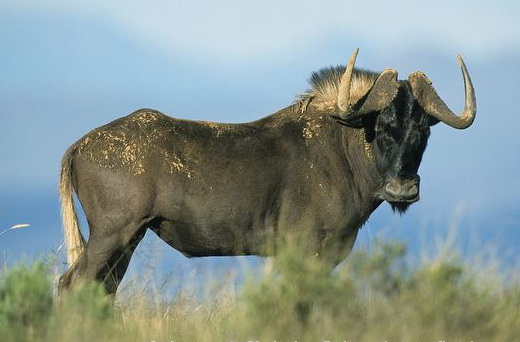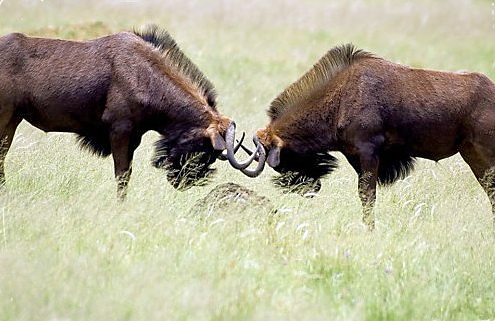10 Interesting Black Wildebeest Facts and Pictures | With the blue wildebeest, the black wildebeest is member of wildebeest species. Black wildebeest can be found in the plains of Africa especially in Lesotho and South Africa, and also in Kenya, and Swaziland.
Interesting Black Wildebeest Facts and Pictures
Because of that, some wildlife conservation agencies then made protection to allow the black wildebeest recovering.
And now the wildebeest species has been reintroduced widely wildebeest, both in private areas and nature reserves throughout most of its former range in Lesotho and Swaziland and into farmland areas outside of its natural range in Namibia.
The black wildebeest is also known as white-tailed gnu.
This wildebeest species is certainly the most bizarre living antelope with the mane and tail of a horse, the face of a steer and the delicate legs of a buck.
The black wildebeest appearance is matched by its freaky behaviour.
The name ‘black” of the black wildebeest is misleading as the animal is a dark brown, while the name “white-tailed” of white-tailed gnu, which refers to the cream-white tail, is more relevant.
Black Wildebeest Facts and Pictures
Both male and female black wildebeest have well-developed horns that have their origins in a thickened boss on the head and then extend forwards in a deep, downwards curve.The anterior halves of the horns are straight and then project vertically upwards with the tips bent slightly backwards.
The horns of cows are thinner than those of the bulls and are thus lighter.
Horn development is relatively rapid and trophy status may be reached at 2.5 years of age.
The black wildebeest is a species characteristics of the open plains grasslands and karoo shrublands of Africa (Lesotho and South Africa).
The high central plateau grasslands are characterized by flat to rolling hills, and mountainous areas with altitudes ranging from 1,350-2,150 m.
The black wildebeest is predominantly a grazer and prefers short grassveld.
If located in a habitat that is not optimal, black wildebeest will transform the structure of the herbaceous vegetation destructively by ploughing the soil with the horns and front hooves.
Due to the size and power of the black wildebeest, it has no natural predators in its native environment.
The main threat to this wildebeest species was hunting by human, habitat loss, and periodic outbreak of disease.
However, now that the species has recovered and numbers are increasing, the only significant threat is the problem of hybridization with the common wildebeest (C. Taurinus), which can occur when the two species are mixed unnaturally on fenced land.
Hybrids of both wildebeest species are known to be fertile.






Interesting post... I like this particular blogging niche, although it is probably hard to make decent money on blogger while typing about topics of this nature. Speaking of that, I also tried to have a pretty cool Nature & Wildlife BlogSpot Blog but -even though it is full of decent content - the traffic is yet to pick up; blah!
ReplyDelete